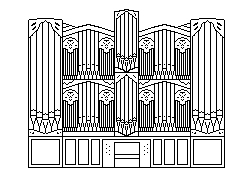|
Schnitger-Silbermann Comparison
The two "schools" of German organ-building that you need to learn about first as an undergraduate are
- The North German seventeenth-century organs, best represented by Arp Schnitger's instruments.
- The "Bach" organs of eighteenth-century central Germany, best represented by the instruments of
Gottfried Silbermann.
I assume you are reading these pages as a part of my class, so you should know about the Schnitger
organs by now. It might help you to make a comparison between these two types of organ, although,
again, the comparison will be made verbally. We can summarize the differences between the two in these
categories:
- Social position
This might seem like a strange thing to talk about, but it's actually important. In north
Germany many of the largest organs were built with the support of people who were business
leaders, or organizations of such business leaders. Shipping and trade were the driving forces
behind Dutch and North German society in the late seventeenth and eighteenth centuries, and
the financial importance of an organization or of a city was publicly displayed in various ways
- - including the building of great, monumental organs. In a sense, this was advertising, or
maybe a form of community service comparable to a multinational corporation buying computers
for an inner-city school today.
The large cases of the northern organs are evidence of this desire to impress upon
the people the importance of the donors. The sound of the organs was equally bold. The
desire to astound through splendor is both visible and audible.
On the other hand, the organs of central Germany were supported by cities, business
organizations, and individuals whose resources were more limited. In some ways, we can think of
central German organs as "small town" organs, simply because they were
smaller, less commercially oriented, perhaps even less vigorous. The people of these central
German cities and towns were more settled and members of a more staid, older society. With the
continuing importance of older noble families, who wielded more influence than commercial
organizations, you can think of central Germany as building organs with "old money," rather than
with the glitzy funds of the "nouveau riche" in North Germany.
- Musical demands
When you think of the music of Buxtehude, the first thing that comes to mind - - especially
if you've just taken Music History I - - is the music he composed for the Abendmusiken,
the impressive services-concerts of Lübeck in north Germany. From that same music history
class, think of the music Bach wrote for the morning services in his church positions:
cantatas and organ chorales. Of course, both composers wrote organ settings of chorale tunes,
and both wrote impressive Praeludia, or preludes and fugues. But the different emphasis
within the musical output of Buxtehude and Bach shows the different requirements of their
positions. The intensely personal
and inwardly directed religious life of central Germany required intensely personal and
individualistic organ sounds. We find those requirements reflected in the multiple color stops,
including strings and soft flutes, of the central German organs. The organs of
eighteenth-century central Germany were built to serve musical requirements that were
different from those of North Germany.
- Quality of sound
The differences in sound between the organs of Schnitger and Silbermann are, of course,
the result of different scalings, voicing, placement, and even room shape
and size.168
If we were to summarize the differences in their sounds, though, we could say
that the Schnitger sound is more overt, more open, more "up front" in quality. On the
other hand, the Silbermann sound is more inward, more reserved, more refined. These words
mean little on their own, to be sure, but they can serve as a framework for your own
descriptions of the different sounds.
The first step you can take is to listen to good recordings of both types of instrument. Then,
search for some new instruments in the United States that have been built in the style of one
or the other builder. Finally, make it a goal to go hear some of the surviving works of both
Schnitger and Silbermann. Seeing them and hearing them in their original locations is the
final step in learning the differences between them.
|


 Andreas Silbermann and
his son Johann Andreas worked in Alsace, the area indicated by a small red circle on the map to the
left.
They both built some outstanding instruments that are extant there, and Johann Andreas continued to
build organs through the late eighteenth century.
Andreas Silbermann and
his son Johann Andreas worked in Alsace, the area indicated by a small red circle on the map to the
left.
They both built some outstanding instruments that are extant there, and Johann Andreas continued to
build organs through the late eighteenth century.  Most of the time,
though, when you hear someone mention a "Silbermann" organ, the speaker will mean an instrument built by
Gottfried, the younger brother of Andreas. Gottfried actually started his career working with
Andreas, and he absorbed a few French characteristics from his organs. The center of his activity as an
independent builder was in Saxony, however, the area indicated by the red
circle on the map to the right. This part of Germany includes Leipzig, where Bach spent more than
twenty-five years, but Bach never held a position where he played a Silbermann organ on a regular basis.
We do know his reactions to Silbermann's organ in the Frauenkirche in Dresden, though, so you
might say that Bach is "on record" as having approved of Gottfried Silbermann's work as an organ
builder.
Most of the time,
though, when you hear someone mention a "Silbermann" organ, the speaker will mean an instrument built by
Gottfried, the younger brother of Andreas. Gottfried actually started his career working with
Andreas, and he absorbed a few French characteristics from his organs. The center of his activity as an
independent builder was in Saxony, however, the area indicated by the red
circle on the map to the right. This part of Germany includes Leipzig, where Bach spent more than
twenty-five years, but Bach never held a position where he played a Silbermann organ on a regular basis.
We do know his reactions to Silbermann's organ in the Frauenkirche in Dresden, though, so you
might say that Bach is "on record" as having approved of Gottfried Silbermann's work as an organ
builder.